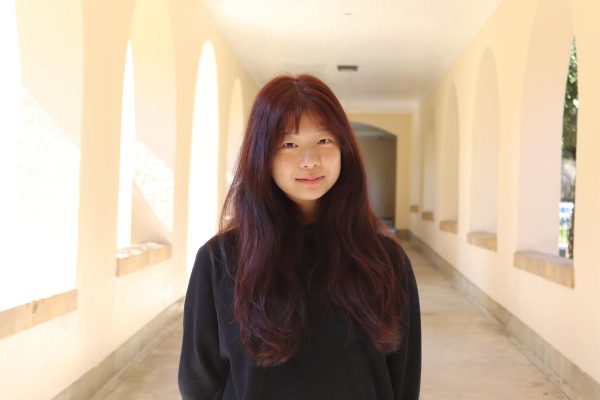The grey, polluted sky looms above a desolate landscape. Once, colorful truffula trees covered the land. Now, nothing but stumps remain, and society is ruined by the greedy needs of the thneeds. This is a scene from “The Lorax,” an animated film that uncovers the unfortunate truth of industrialization and environmental destruction through the lens of a seemingly innocent children’s movie.
From this dreary town of Thneedville to OASIS, the virtual universe in “Ready Player One,” dystopian worlds and environmental collapses have been used by filmmakers to captivate audiences worldwide. As the world is changing quicker than ever, viewers come to ponder whether the dystopian universes we see on screen could reflect the future.
Palo Alto High School junior Brendan Giang, a student film writer and Paly Film Club participant, believes that films have the potential to shape one’s perception of the planet’s future, including the future of humanity.
“[Watching environment documentaries] may give you hope and may give you despair,” Giang said. “Film as a media has such an opportunity to have a massive impact on a lot of people, which can be good in a lot of ways and can also be bad in a lot of ways.”
For some viewers, these films act not just as entertainment but as a warning. Senior Emma Yang, a Paly film composition literature class student, believes these films can reveal insights regarding dangers to the environment.
“[Films are] a really interesting way to learn about real-world issues,” Yang said. “It puts into perspective what the worst-case scenario could look like. That’s something people really need because nowadays we can be kind of ignorant towards problems, and I honestly don’t think people will really realize how much harm we’re doing to the environment until something really terrible does happen.”
Similarly, for Paly journalism advisor Paul Kandell dystopian media is a look into the future and the possibilities that could occur.
“Dystopian movies really outline some incredible visions for what challenging times could look like,” Kandell said.
According to sophomore Neva Bapna, apocalyptic films often blur the lines between entertainment and environmental warning.
“[Films paint] a very clear path of how our world could just go into shambles, and that’s kind of scary,” Bapna said. “They’re helpful in the way they help people understand the possibility of these scenarios happening, but it also does create a lot of anxiety.”
Audiences may perceive dystopian films and media as pure fiction due to the uncanny and at times abnormal elements. Librarian Sima Thomas has seen how additional entertainment can desensitize the actuality that these movies portray.
“Just like parody humor, if we focus too much on the laughing or the fun aspects that aren’t actually as realistic, it can create this sense of ‘Oh, that’s another world. That’s not our problem,’” Thomas said.
Andrew Brown, president of digital marketing and distribution at Neon, believes that dystopian movies have always been relevant to concerns about the future. Neon, the independent film production and distribution company behind the recent five-category winner at the Oscars, “Anora,”, has released various dystopian movies, including “Crimes of the Future” directed by David Cronenberg, and recently has let out “The Monkey,”, a new film about a devious doll.
“Throughout history, we’ve all believed we’re ‘near’ or ‘in’ the end times, and our society is near collapse,” Brown said. “Art has always been a good filter to help analyze these fears. Dystopias are generally about societies that are subjectively seen as unjust or corrupted, so there’s a lot of fiction that can be perceived as a dystopian story.”
Art and fiction are elements in many movies, and they help deliver the messages and themes of the stories. When Dystopian movies offer troubling images of a possible future, aspects of fiction and picture make this possible.
“Zombie outbreak movies are probably the most popular delivery system for these stories, but you can look at it in a lot of ways, like ‘The Matrix,’ which argued some prefer illusion over reality, which is why it’s easier for people to digest criticisms through fiction: red pill or blue pill?” Brown said.
Among many narratives that often end in world destruction, Brown has found a film that highlights many realistic fears but also shows hope for the future.
“‘Children of Men’ is arguably my favorite of the 21st-century dystopian films and best captures the hopelessness that many feel in the shadow of our current cultural and agricultural concerns,” Brown said. “The backdrop of the film shows many familiar elements — population collapse, ecological decay, extremist factions, class warfare — but at the center of it all, it’s about isolation.”
The sense of isolation in the film mirrors how modern society feels, where a lack of connection can be just as abysmal as a worldly collapse.
“The core conceit being humanity’s decline into infertility works well to show how all our hope hangs on community and connectivity, so in the final moments of the film when we see the cycle start again, despite not having an explicit path back to the light, the audience knows that the simple idea of family is the key,” Brown said.
If Brown was to suggest a film that younger generations should watch, it would be “Idiocracy”.
“‘Idiocracy’ is one of the funniest cinema dystopias,” Brown said. “Mike Judge made a small film in 2006 that imagines all of humanity descending into an age of complete stupidity, where we’ve abandoned dignity and intelligence for corporate-subsidized cities and goods. It’s still funny today, and sadly, eerily prescient.”
While many movies leave the audience anxious about the future, it’s crucial to have a light-hearted element to films.
Dystopian films hold a variety of possibilities, yet some stand to be much more likely than others. Foothill College Professor of Environmental Horticulture Gabrielle Sala thinks the environmental depictions shown in dystopian movies are a real possibility.
“They always depict the earth as not being able to grow,” said Sala. “The soil is terrible and there’s no living plant life on earth, which could be a possibility.”
Even so, the downfall of one part of an ecosystem can be detrimental to a species.
“Ecosystems provide essential services, human well-being and survival of countless species, so when we don’t have that life-supporting clean air and food sources in soil health, we will not be able to survive or thrive as a community,” Sala said.
While a portion of dystopian movies focuses on government corruption or an autocratic regime, there is a theme of underlying environmental collapse that ties in with all other dystopian motifs.
“There is a lot of overlap between the autocratic, oppressive, exploitative regime and ecosystem breakdown, and this is kind of what we see in the real world,” Thomas said. “When resources become more and more scarce, the fight to control those resources becomes more and more intense. That plays out in our world right now.”
In contrast to the cynical aspects of dystopian media that many audiences may be drawn to, some people find themselves connecting to the genre in a much more hopeful and personal sense.
“There is a lot of relatability even in this kind of fictional and dystopian world,” Thomas said.
Many, like Thomas, are able to find heartfelt meaning in Dystopian media by reflecting on their experience and takeaways.
“You get this protagonist who’s an unlikely hero,” Thomas said. “They start out kind of scrappy or insecure, then they figure out how to rely on themselves, on other people, how to come together and work for the good of the world or the community.”
The themes of struggle and connection can also be found throughout these stories. Many find dystopian media to bring out their emotion and empathy.
“The protagonist is somehow able to leave the world at the end of the story in a more hopeful place,” Thomas said. “There’s this element of hope in them, and it helps us connect with the underdog, the struggle and also the success of the struggle. There is something more important than just winning or just surviving, and it is being human.”
While sometimes it feels like the Earth is becoming a closer representation of viewer’s favorite dystopian movie, these stories can serve as a reminder that the future is not set in stone, but instead it is shaped by the actions and choices made today.











